


 The Answer to my Prayers
The Answer to my PrayersLast year I played the Dutch and the English Defense. While I had good results online with the Dutch, I had really bad experiences in over-the-board events; where real chess is played! So this year I desperately needed to make a change in my opening repertoire as black against 1.d4. The answer to my prayers came in the form of The Triangle Setup DVD from Michal Krasenkow and ChessBase; which makes Caissa a real goddess, because she answered my prayers.
GM Krasenkow is a coach at heart, and the first thing that hit me was in his introductory video where he advises the viewer: "you need to play this opening, and then come back to the DVD for guidance, and see where you deviated from the lines proposed here."
This advice was right on the mark, because it is the only way to truly learn an opening. I followed it to the letter: I began to watch the videos, then played a lot of blitz games, where I had some bad surprises. Then I returned to the videos and discovered what my mind remembered wrong! It was a great learning experience, and I am happy to have become a student of such a great teacher through this DVD.
The format and content of the DVD is as follows:
One video of introduction
One video on the line 1.d4 d5 2.c4 e6 3.Nf3 c6 4.Bg5 Be7 5.Bxe7 Qxe7

One video on the line: 1.d4 d5 2.c4 e6 3.Nf3 c6 4.Nbd2 f5 this is where GM Krasenkow recommends the Stonewall to fight against this White structure.

Two videos on the line: 1.d4 d5 2.c4 e6 3.Nf3 c6 4.g3 dxc4 5.Bg2 b5

Three videos on the line: 1.d4 d5 2.c4 e6 3.Nf3 c6 4.Qc2 dxc4 5.Qxc4 Nf6
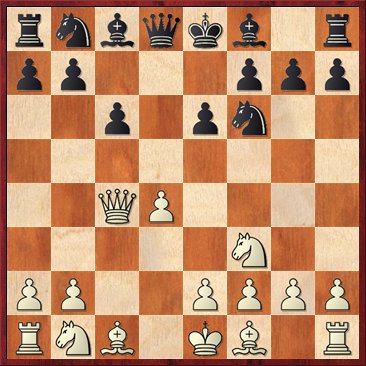
Four videos on the line: 1.d4 d5 2.c4 e6 3.Nf3 c6 4.e3
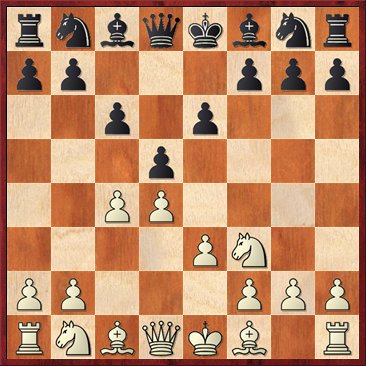
One video on the line: 1.d4 d5 2.c4 e6 3.Nc3 c6 4.cxd5

One video on the line: 1.d4 d5 2.c4 e6 3.Nc3 c6 4.e4

Eight videos on the Noteboom: 1.d4 d5 2.c4 e6 3.Nc3 c6 4.Nf3 dxc4

The theoretical videos are followed by thirteen clips of test positions; these allow the student to gauge their understanding of the topics discussed in the videos. Then there is an extra database with eighty deeply annotated games, and five theoretical articles written by GM Krasenkow to give the student a better understanding of the recommended lines.
Here is one of the games from the database. In this game it is possible to see the traditional tactics played in this opening, how to mount an attack on the kingside, with relative piece play, and a beautiful sacrifice:
Gleizerov,Evgeny (2545) - Hector,Jonny (2500)
Excelsior Cup Gothenburg (4), 10.01.1997
Open Catalan [E04]
Annotations from CBM 57 are updated and adapted for this survey; my additional notes are marked MK.
1.d4 d5 2.c4 c6 3.Nf3 Nf6
MK: 3...e6 4.g3 dxc4 5.Bg2 b5 6.0-0 Bb7 7.a4 Nf6 8.Ne5 a6 9.Nc3 Qb6 - game
4.Nc3 e6 5.g3 dxc4 6.Bg2 b5 7.Ne5 Qb6 8.0-0 Bb7 9.a4 a6

10.e4
MK: 10.b3 cxb3 11.Qxb3 is not dangerous for Black: 11...Qxd4 (11...Be7 12.Be3 Nd5, like in Romanishin - Goloshchapov, is quite possible, too; 11...b4!?) 12.axb5 axb5! 13.Rxa8 Bxa8 14.Bf4 Bb4 15.Nxb5 cxb5 16.Bxa8 0-0= 1-0 Tregubov,P (2642)-Fier,A (2653)/Barcelona 2009/CBM 133 (39)
10...Nfd7
10...c5!? 11.d5 Nbd7 12.f4, with compensation; MK: 10...Be7 is risky due to 11.d5! cxd5 12.exd5 0-0 (12...exd5 is now bad as the rook on a8 is always hanging, cf. annotations to Romanishin - Goloshchapov: 13.Nxd5 Nxd5 only move 14.Bxd5 0-0 15.Be3 Qc7 16.Bf4+/-; better is 12...b4 13.Be3 Qc7 14.d6! Bxd6 15.Bxb7 Qxb7 16.Qxd6 bxc3 17.Rfd1 with initiative) 13.d6 Bxd6? (13...Qxd6 only move 14.Bxb7 Ra7 15.Qf3+/-) 14.Bxb7 Ra7 15.Bg2 Bxe5 16.Be3 Qc7 17.axb5+- 1-0 Krasenkow,M (2495) -Sherbakov,R (2495)/Katowice 1992/TD (27); MK: 10...Nbd7 is more accurate than the text move. White has hardly anything better than 11.Nxd7 (11.Be3 Rd8 12.Qe2 c5! 13.axb5 axb5 14.Nxd7 Nxd7 15.d5 Be7 is good for Black)
11.Nxd7
11.Bf4 Ftacnik 11...Nxe5 12.Bxe5 Nd7 13.Bf4 unclear; MK: 11.Nf3!?
11...Nxd7 12.d5
12.Be3 Ftacnik 12...b4 13.a5 Qc7 14.Ne2 unclear
12...Bc5
12...b4!? 13.dxe6 fxe6 14.Ne2!, with compensation, is sound, with black's compromised pawn structure offering white at least enough compensation for the sacrifice.; MK: I don't see any problems for Black after 12...cxd5 13.exd5 e5, e.g. 14.Ne4 (14.Be3 Bc5 15.Qg4 g6) 14...Bc5 15.Qg4 Qg6 0-1 Pukkila,M-Kilpi,T (2270)/Kuopio 1995/EXT 2000 (38); MK: 12...e5!? 13.Be3 (13.dxc6 Qxc6 14.Nd5 Bc5 15.axb5 axb5 16.Rxa8+ Bxa8 17.b4 cxb3 18.Bh3 Nb6 19.Nxb6 Bxb6 20.Ba3 b2 21.Qd2 Bd4 22.Qb4 Bc5 23.Qxb2 Bxa3 24.Qxa3 Qxe4-/+ 0-1 (39) Halkias,S (2574)-Dvirnyy,D (2520) Istanbul 2012; 13.b3 b4 14.dxc6 Qxc6 15.Nd5 c3 16.a5 Bc5-/+ 1/2 (56) Dvirnyy,D (2515)-Alsina Leal,D (2540) Forni di Sopra 2012) 13...Qd8 deserves attention, too.
13.dxe6 fxe6 14.Bh3

14.Qg4 0-0 gives black good counterplay on the f- and e-lines.
14...Rf8
Black plays with a great risk, his counterplay may not be strong enough.
14...Nf8 looks better. Although black's king is in danger here, it seems even more exposed in the game. 15.Qg4 (15.a5 Ftacnik 15...Qa7 16.Qh5+ g6 17.Qe2 with counterplay)
15.Qe2
White prefers to keep his king position as solid as possible, in keeping with a sensible Russian style.
15.Bxe6! is the critical move. 15...Bxf2+ (15...Rd8 16.Qh5+ g6 17.Qxh7+/-) 16.Kg2
A) 16...0-0-0 17.Bg5 (17.Bg5 c5 18.Bg4 Bd4 19.Bxd7+ Kxd7 20.Bxd8 Rxd8+/-);
B) 16...Rd8 Ftacnik 17.Qh5+ g6 (17...Ke7 18.Bxd7) 18.Qxh7+/-;
C) 16...Nc5 17.Qh5+ (17.Bh3 Nd3 18.Qh5++/-; 17.Bxc4 bxc4 18.Qh5+ Kd8 19.a5 Qb4 unclear) 17...g6 18.Qe5 Nd3 19.Qg7 threatening Qd7 and Bh6. Black's position looks shattered, for example, 19...Bc8 (19...Nc5 20.Bg5) 20.Bh6 wins. However, Gleizerov is not so confrontational, and prefers the neater path. Neat is practical, but sometimes neat is second best.
15...Bd4
By controlling the e5 square, black prevents the kind of invasions seen in the previous note. He also greatly improves the coordination of his pieces (his queen is no longer bound to defend c5 against Qh5+ routines) and the bishop on d4 monitors both sides of the board.
16.Bxe6 Nc5 17.Bh3
17.a5 Ftacnik 17...Qc7 18.Bf5 g6 unclear
17...Kf7
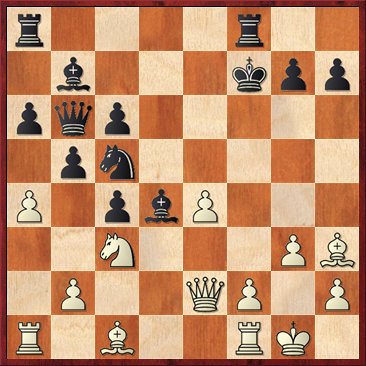
Simply castling by hand and creating the kind of pressure on the e- and f-lines seen in the note to white's 14th move. Nevertheless, black must use quite a bit of time to set up this counterplay now, and white should be able to secure his advantage in the meantime.
18.axb5
This move tends to improve black's chances in this type of position, and here does not seem to be an exception. The use of the d5 square is more than balanced by Black's improved pawn structure and activated bishop on b7.
18.Be3 is more what I would expect from Gleizerov.
A) 18...Rad8 19.axb5 axb5 (19...cxb5 20.Nd5!) 20.e5 is obviously better for white.;
B) 18...Bxe3 19.Qxe3 Kg8 is perhaps the best of the alternatives.;
C) 18...Nd3 19.Qh5+ (19.Bxd4 Ftacnik 19...Qxd4 20.Qh5+ Kg8 21.Be6+ Kh8 22.Bf5 g6 23.Bxg6 Qg7 24.Bf5 Nxb2 unclear) 19...Kg8 20.Be6+ Kh8 21.Bf5 is terrible for black.
18...cxb5 19.Nd5 Qd8
19...Bxd5?! Ftacnik 20.Qh5+ Ke7 21.Bg5+ Bf6 22.exd5+/-
20.Rd1 Nd3 21.Qh5+
21.Rxd3 Ftacnik 21...cxd3 22.Qxd3
A) 22...Bxd5?! 23.exd5 Qxd5 (23...Qf6 24.Be6+ Ke8 25.Be3+/=) 24.Be3 Rad8 25.Rd1+/=;
B) 22...Ba7! 23.Qb3 Kg8 24.Be6+ (24.Nb6+ Kh8 25.Nxa8 Bxf2+ 26.Kf1 Bxg3+-+) 24...Kh8 25.Bf4 Bc8=/+
21...Kg8 22.Be6+
22.Be3 Ftacnik 22...Bxe3 23.fxe3 Qe8-/+
22...Kh8 23.Bf5
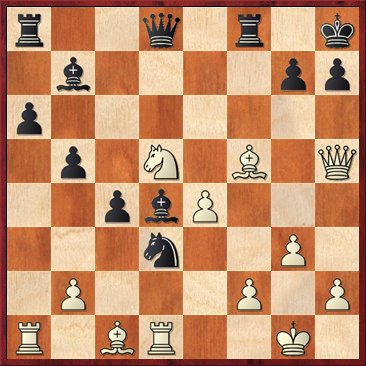
White has achieved the kind of attack we have seen in other variations, but with his own king in the firing line as well.
23.Be3 Ftacnik 23...Bxe3 24.Nxe3 Qf6-+
23...Bxf2+ 24.Kg2
24.Kf1 Ftacnik 24...g6 25.Bxg6 Qd7 26.Nf4 Qg7 27.Bf5 Bb6-/+
24...g6
24...h6!? 25.Qg6 (25.Bxh6 Rxf5! 26.Qxf5! gxh6 27.Rxd3 cxd3 28.Qe5+) 25...Rxf5 26.Qxf5 Bd4 gives black good compensation for the exchange. White is greatly hampered by the need to keep the bishop on b7 blocked. However, there is no need to sacrifice anything yet either.
25.Bxg6 Qd7 26.Nf4
26.Bf5?? Rxf5 27.Qxf5 Qxf5 28.exf5 Bxd5+; 26.Bd2 Ftacnik 26...Bd4 27.Bc3 Bxc3 28.bxc3 Qg7-+
26...Qg7! 27.Bf5?
Gleizerov walks into a sneaky punch. Better was 27.Nxd3 cxd3 28.Bf5 But there are a lot of nasty tricks to watch out for here as well.
A) 28...Rad8? 29.Bh6 Qf7 (29...Qxb2? 30.Bxf8 and black has no meaningful check.) 30.Qxf7 Rxf7 31.Kxf2 Bxe4 32.g4;
B) 28...Rxf5! 29.Qxf5 Rf8 30.Qe6 Qd4 31.Bf4 Bxe4+ 32.Kf1 Be3 (32...Bg1 Ftacnik 33.Rd2 Be3 34.Rf2 Bxf4 35.gxf4 d2-/+) 33.Qe7! and white will be happy if he escapes with a draw. (33.Qe7 Kg8 34.Qe6+ Rf7-/+)
27...Rxf5 28.Qxf5 Rf8 29.Qe6
29.Qh5 Ftacnik 29...Rxf4! 30.Rxd3 Bxe4+ 31.Kh3 Bf5+ 32.Kg2 Qb7+-+
29...Qd4
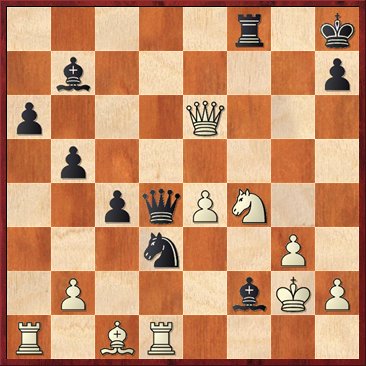
The presence of the knights, by comparison to the previous note, must favor black, whose steed is a monster on d3.
29...Nxc1?! Ftacnik 30.Rd7
A) 30...Rxf4
A1) 31.Rxg7 Bxe4+ 32.Qxe4 (32.Kf1 Bxg3+ 33.Kg1 Ne2#) 32...Rxe4 33.Rb7 Nd3 34.Rxa6=/+;
A2) 31.Rxb7 Qxb7 32.gxf4 Qg7+ 33.Kf3 unclear;
B) 30...Bxe4+ 31.Qxe4 Qxd7 32.Qe5+ Kg8 33.Qg5+ unclear; 29...Rxf4 Ftacnik 30.Rxd3 Bxe4+ 31.Qxe4 Rxe4 32.Rd8+ Qg8 33.Rxg8+ Kxg8 34.Kxf2+-
30.Nd5
Loses by force. 30.Nxd3 Ftacnik 30...Bxe4+-+; 30.Qe7! Ftacnik 30...Qxe4+ 31.Qxe4 Bxe4+ 32.Kh3 Bf3 33.Nxd3 Bxd1 34.Nxf2=
30...Be1!
Now the king hunt begins. Since the h3 square is off-limits due to the sudden appearance of black's bishop on c8 when needed, the white king has limited room to run. 30...Ne1+ Ftacnik 31.Kh3 Qxd1 32.Qe5+ Kg8 33.Qg5+ Kh8=
31.Be3
31.Ra3 Ftacnik 31...Bc8-+
31...Qxb2+ 32.Kg1
32.Kh1 Ftacnik 32...Rf1+ 33.Bg1 Rxg1+ 34.Kxg1 Qf2+ 35.Kh1 Qf1#
32...Bf2+ 33.Bxf2
33.Kh1 Qe2! (33...Qe2 Ftacnik 34.Bxf2 Nxf2+ 35.Kg1 Ng4 36.Rd2 Qxd2 37.Qxg4 Qd4+-+)
33...Qxf2+ 34.Kh1 Bc8!
Also 34...Qf3+ Petursson 35.Kg1 Bxd5 36.exd5 Nf2 37.Qe5+ Rf6 38.Qe8+ Kg7 39.Qe7+ Kg6 40.Qe8+ Kh6-+
35.Qe7
35.Qb6 Ftacnik 35...Bg4! 36.Rxd3 Qxb6 37.Nxb6 cxd3-+ (37...cxd3 Petursson 38.Nd5 d2 39.Ne3 d1Q+ 40.Nxd1 Rf1+ 41.Kg2 Rxd1-+)
35...Bh3 0-1
White is mated on the light squares. Hector can still please a crowd.
My one objection is that the subtitle of the DVD is slightly misleading because it only includes a repertoire for Black after 1.d4 d5 2.c4, and it does not address many of the club level openings such as the London System, the Veresov, or the Torre Attack. In fact, Krasenkow begins his remarks with "Dear Chess Friends, the Semi-Slav Defense followed by e7.e6 and c7-c6... etc.," and he always only refers to moves after White has played 2.c4.
However, thanks to living in this wonderful Internet age, I contacted the author directly to address this problem, and he kindly answered with the following: "No, I don't cover Queen Pawn's Opening (without c2-c4) at all. I don't think the Triangle makes sense in that case." I asked him if he would do a second DVD covering those, let's say, unorthodox openings arising after 1.d4, which are quite common at club level, and his answer was: "No, it is a marginal topic from Black's point of view."
I also checked how many games Krasenkow had against the openings I mentioned above, and, in fact, ninety percent of the games in which he faced 1.d4 the opponent also played 2.c4; only six games, out of hundreds, were played without 2.c4. So the DVD only covers 1.d4, followed by 2.c4, though the author does a good job for that.
Of course, the next question for tournament players like me is what to do if White plays one of those other systems. Well, luckily ChessBase is the answer! Against a possible Catalan setup, GM Krasenkow suggests Black should use a Dutch Stonewall. An opening covered in depth by IM Valeri Lilov (one of the greatest coaches in the world!). For non-orthodox 1.d4 openings IM Andrew Martin covers those openings that occur frequently at club level, and which are not covered by GM Krasenkow.
With regard to The Triangle Setup I really like GM Krasenkow’s DVD, and found that every time I lost a game, I just had to return to the DVD and see what I missed. This is a product I will return to over and over, and I am quite happy with it.
My assessment of this product:
![]()
© 2015 ChessEdu.org. All Rights Reserved.
Published with kind permission of Chesscafé.com
Sample video
 |
Michal Krasenkow: The Triangle Setup
|